|
WALLACE TRAIL
| Introduction
This section shows some of the important locations from the life of William Wallace and the Wars of Independence, from major visitor attractions such as the National Wallace Monument to smaller locations associated.
If you know of other sites that should be included please email details by clicking Wallace 700. |
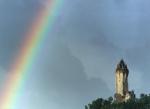
National Wallace Monument © Newsquest (Herald & Times)
|
The National Wallace Monument
|

Wallace Monument, Stirling © Charles McKean
|
The National Wallace Monument stands on Abbey Craig, about 2 miles north of Stirling. This magnificent building can be seen for miles around and forms one of the most impressive sights in Scotland. The tower is so well situated that it seems to form part of the natural landscape.
|
|

National Wallace Monument, Stirling © Stirling Smith Art Gallery & Museum
|
The 220ft high stone structure had a difficult construction, with money being the major problem (the monument was funded completely by public subscription). The foundation stone was laid in 1861, on Bannockburn Day, but the rest of the building took 8 years to complete, until it was finally opened in 1869 on the 11th September - the same date as the famous Battle of Stirling Bridge which took place on the land below it.
|
|

The crown © Scottish Media Group
|
Visitors can climb the 246 steps to the open level at the top, under the crown arches, which offers a wonderful 360 degree view of the Ochils, Stirling and the surrounding countryside. On a clear day it is possible to see the Forth Bridges to the East and, to the West, Scotland's most southerly Munro: Ben Lomond.
|
|
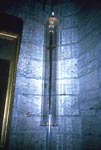
The Wallace Sword © Stirling Smith Art Gallery & Museum
|
There are 3 interior levels to the Monument, which are given over to displays about Scotland's heroes, a recreation of the Trial of Wallace in London and one of the few artefacts directly associated with William Wallace: his sword. The sword is 5ft 4inches in length and has marks on its blade denoting its use in combat. It left Scotland for the first time in 700 years in 2005 when it was taken to form part of the Tartan Day celebrations in the United States of America.
| Back to top
|
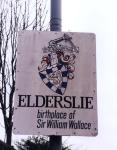
Elderslie town sign © Scottish Media Group
|
Elderslie is regarded by most authorities as being the birthplace of William Wallace. There has been much debate amongst historians as to the location, whether it was Elderslie near Paisley in Renfrewshire or Ellerslie in Ayrshire, and much evidence and speculation has been put forward for each case. It will never be known for sure. |
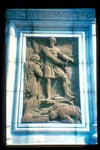
Panel of the Wallace Monument © Stirling Smith Art Gallery & Museum
| Back to top
Lanark is a famous place in the history of William Wallace. It was where he lived for a time and also where he rose to prominence in the Wars of Independence after he killed the English Sheriff Heselrig in 1297, as possible revenge for the killing of his wife, Marion Braidfute. It is thought he married in St. Kentigern's Church, which is now a ruin. As the highest point in Lanark it has spectacular views over the Clyde Valley and to the hills beyond. The Church is situated off Hyndford Road, Lanark.
|
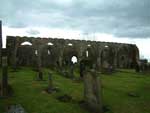
St. Kentigern's Church © South Lanarkshire Council
|
Nowadays the town's Lanimer celebrations in June include the Crowning of the Queen under the statue of William Wallace on the side of St Nicholas' Church. The Wallace sculpture is decorated each Lanimer and also at Christmas. The Lanimer celebrations stem from the town's establishment as a Royal Burgh in 1140. The town's leaders would have to examine the town's boundaries each year.
|

Ancient Lanark Lanimers festival crowning the Lanimers Queen © Newsquest (Herald & Times)
|
| The site adjacent to Castlebank Park was once home to Lanark Castle, and was where the Sheriff of Lanark was slain by Wallace in revenge for the murder of Marion. It is accessible from both Castlebank Park and the Clyde Walkway. |
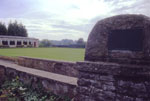
Site of Lanark Castle © The Royal Burgh of Lanark Museum Trust
| Back to top
|
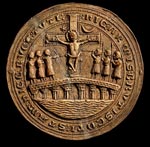
Cast of town seal © National Museums of Scotland
|
Stirling Bridge is the location of the famous battle of 1297, when the Scottish army led by William Wallace and Andrew Murray defeated the English army. It was the first time an army under Wallace had fought a large pitched battle following his guerilla war. This seal from 1296 shows a representation of the original wooden bridge.
|
|
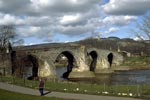
Stirling Bridge (current day) © Charles McKean
|
The wooden bridge was replaced by a stone bridge in the late 15th century. It is known as the "Old Bridge" and is looked after by Historic Scotland. A more modern bridge was built in the 19th century.
| Back to top
Falkirk was the site of William Wallace's last battle in command of the Scots army. On 22nd July 1298 he faced the English army, commanded by Edward I. The Scots were defeated and many thousands were killed. The battle is marked by a monument at Wallacestone, which is named after the stone from which Wallace is reputed to have overseen the battle.
|
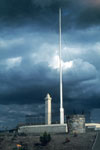
Wallacestone Monument © Stirling Smith Art Gallery & Museum
| Back to top
|

Dumbarton Castle © Anne Buddle
|
Dumbarton Castle sits on Dumbarton Rock on the north bank of the River Clyde. It is a very strategic location and has been used as a castle, or fortified site for many centuries. William Wallace was taken here as a prisoner before being taken to London for his trial and execution in 1305. On the guardhouse there is a gargoyle carved with a horribly constricted face that is reported to be the "fause (false) Menteith" " Sir John Menteith, the keeper of the castle who is regarded as being the man who deceived Wallace, leading to his capture.
| Back to top
| Many monuments have been put up to commemorate the memory of Wallace around the world, from the early 19th century onwards.
|

Bruce Statue at Stirling Castle and Wallace National Memorial © Douglas Skelton
|
Dryburgh
|

Wallace Monument, Dryburgh © Padeapix
|
The first memorial in Scotland to be built in Wallace's memory was at Dryburgh. It was paid for by David Steuart Erskine, the 11th Earl of Buchan and unveiled in 1814. His contemporary the famous novelist Sir Walter Scott hated it so much he wanted it blown up! It remains an impressive piece of public art: 21 feet of red sandstone, on a 10 feet plinth, placed on a commanding position overlooking Dryburgh Abbey, the Tweed Valley and towards the Eildon Hills. |
Ayr
Ayr has the Wallace Tower which is 113 feet high and has a statue of William Wallace on its side and a clock taken from the previous one that is mentioned by Robert Burns in his poem "The Brigs of Ayr": "The drowsy Dungeon-clock had number'd two, and Wallace Tower had sworn the fact was true".
|
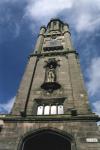
Wallace tower in Ayr High Street © Newsquest (Herald & Times)
|
Barnweil
|
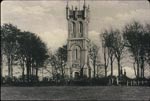
Wallace Monument Tower, Barnweil, Ayr © Stirling Smith Art Gallery & Museum
|
In 1855 the Monument at Barnweil was built. It is located north east of Ayr, between Tarbolton and Symington.
It is claimed that it gets its name from an incident involving William Wallace where he set fire to the local farms' barns, trapping English soldiers. Watching the flames rise he is reported to have said "The barns of Ayr burn weel(well)". It is known that the name was in existence long before Wallace, the Celtic "Barnwiel" or "wield". However, that is not to say he wasn't making a sly pun... |
Burns and Wallace Cairn
This cairn (1929) stands on a small hill near to Auchencruive Agricultural College. It links William Wallace with the poet Robert Burns. Leglen Wood is where Wallace is said to have hidden from English soldiers. Burns spent time in this wood and in 1786 wrote a letter to a friend stating "I explored every den and dell where I could suppose my heroic Countryman to have sheltered, I recollect (for even then I was a Rhymer) that my heart glowed with a wish to be able to make a Song on him, equal to his merits.'" Burns never managed to do this, although the lyrics he wrote to "Scots Wha Hae" on Bruce and Bannockburn are as stirring as any he might have written on Wallace.
|
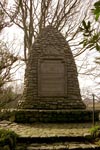
Cairn in Leglen Wood © Douglas Skelton
|
Robroyston
|

Wallace Monument, Robroyston © Stirling Smith Art Gallery & Museum
|
Robroyston is now a suburb of Glasgow, in the north east of the city. The memorial marks the reported location of Wallace's capture in 1305. It was built in 1900. The plaque reads "This memorial erected 1900 AD by public subscription is to mark the site of the house in which the hero of Scotland was basely betrayed and captured about midnight on 5th August 1305 when alone with his faithful friend and co-patriot Kerlie who was slain.
Wallace's heroic patriotism as conspicuous in his death as in his life within nine years of his betrayal the work of his life was crowned with victory and Scotland's independence regained on the field of Bannockburn."
|
Ballarat
It is not just in Scotland that memorials have been built to Wallace and his memory. In Ballarat in Victoria, Australia a statue was unveiled in 1889. The figure of Wallace is based on that of Donald Dinnie, the Scottish athlete who was also the model for the advertising for that other Scottish icon: Irn Bru.
|
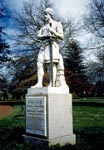
Wallace Statue at Ballarat © Stirling Smith Art Gallery
|
Baltimore
|
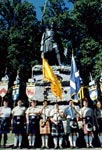
Wallace Statue, Baltimore, Maryland © Susan Hodges
|
In addition to Australia, America also has memorials to Wallace. This one is in Baltimore, in the state of Maryland. It was unveiled in 1893, appropriately on St Andrews Day. It is a copy of the statue at the National Wallace Monument, paid for by Scots residents of Baltimore and supplied by the same sculptor, DW Stevenson.
|
Bannockburn
| Bannockburn is the site of the famous battle fought in 1314. It is situated to the south of Stirling. Robert the Bruce (King Robert I) commanded his army against the forces of Edward II. The battle was fought over 2 days in June of that year. The Scottish army won and sent Edward's army "homeward to think again". |
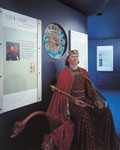
Representation of Robert the Bruce © National Trust for Scotland
|
| The Visitor Centre at Bannockburn is run by the National Trust for Scotland. The sculpture of Robert the Bruce commands a position which is traditionally taken to be where the King oversaw the battle 7 centuries ago. |
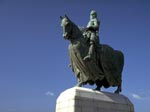
Robert the Bruce Statue at Bannockburn © The National Trust for Scotland
| Back to top
Monkton
|
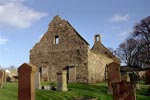
Monkton Kirk © Douglas Skelton
|
The Church of St Cuthbert's and Graveyard Monkton, Ayrshire is Category A listed. It's 13th century, with later additions, ties in with the time of Wallace. The church is ruined after being abandoned in 1837.
Plaque unveiled by the Minster for Tourism, Culture and Sport, Patricia Ferguson on Friday 24 June 2005 marks the spot where William Wallace slept and dreamt of protecting the Covenant of Scotland according to "Blind Harry's Poem". The plaque was instigated and designed by Monkton Historical Society.
Interestingly, the Revered Thomas Burns, nephew of the poet Robert Burns, was Minister of St Cuthbert's from 1830 to 1843. His daughter is buried in St Cuthbert's graveyard. |
|
|







